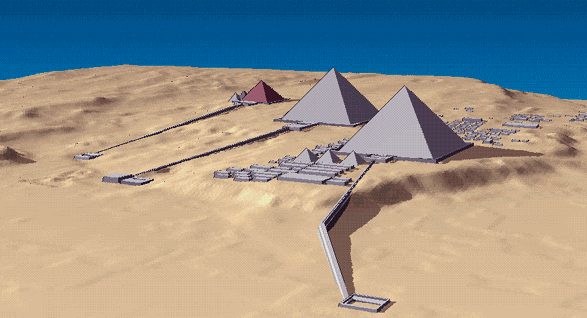
Royal Cubit
The calculation of the length of the Royal Cubit has been under study since
Sir Isaac Newton sent Proffesor Greaves from Cambridge to measure the Kings
chamber in the Great Pyramid in 1639. It is based on Egyptian cubit rods in
museums and also on the work of
Sir William Flinders Petrie,
Colonel Vyse and many others.
see Livio C. Stecchini
The accuracy of Temple construction is not merely a matter of civil engineering
skill but also of astronomical knowledge. This is a complex subject and
requires extensive and accurate record keeping as well as a sophisticated
priesthood. Some interesting research in this area was done by Prof.J. Norman Lockyer F.R.S
and also by F.C.Penrose F.R.A.S. Prof. N. Lockyer found the alignment
and orientation of Egyptian and Greek temples to be very accurately placed in
reference to certain stars and planets and in the case of the great temple in Greece
at Eleusis the star Sirius seems to have determined the orientation as it rose
at midnight along the axis of the temple on Sept 14th, the Eleusian mysteries are
supposed to have begun on the 16th of this month.
Subdivisions included a measure called a digit:
Digit = .7364"
* there are for those with deeper interests in this subject other figures for the digit .729" is more easily used as a factor
in the calculation of Greek and Roman measurement and provides a harmonious relation to other measures ie.1/54 of a meter.
Palm = four digits or 2.945"
.7828"
The smallest division on the cubit measure was 1/448 part of 1 cubit
Remen = 14.58" or 37.033mm this measure was used in Egyptian land measurement. It is based upon the Pythagorean formula for the hypotenuse length as it is the length of a square whose hypotenuse is exactly one Royal Cubit.
Mean length of each side measures out to be 9,069.45 inches or 440:00 Royal Cubits. This figure needs to be understood as not a mere estimate. The Great Pyramid of Giza is probably one of the most accurately surveyed buildings on earth
and has since the late 1800's occupied the skills of many great surveyors beginning with Sir Flinders Petrie. The pyramid base length measurements are founded upon the use of the "original corner sockets" for the outer casing stones which are found buried under the sand
but have since the 1800's when Petrie first found them been available for a serious surveyor to uncover.
The surveys indicate that the base length of the Great Pyramid is to be taken as exactly 440 RC this makes sense, as this measure gives the proportions of the pyramids base length, height, and perimeter as follows.
Pyramid Height = 280:00 RC
Pyramid Perimeter = 1,760 RC
Pyramid Slope = 51.51 deg
Pyramid Cot = .78551 = Pi/4
Mathematical analyis of the Pyramid